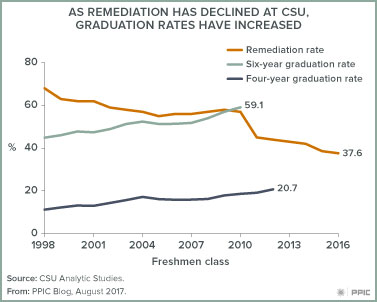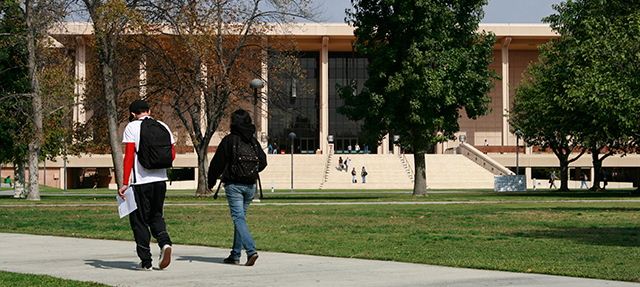Last fall, more than one in three students starting as freshmen at the California State University (CSU) system had to take a remedial course in either English or math before they could take college-level courses in those subjects. These remedial courses generally cover material from high school and don’t count toward a degree—even though they cost the same amount and require as much class time as a college course. But this situation is about to change. Starting in 2018, all CSU freshmen will be placed in college-level courses. Those who are underprepared will receive some kind of extra support.
This is the most recent in a series of CSU reforms intended to place freshmen students into college-level courses. In 2004, the Early Assessment Program (EAP) began giving 11th graders an indication of their readiness for CSU and identified the courses they would need to complete their senior year to avoid remediation. More recently, incoming students who were required to take remediation were enrolled in Early Start, which used summer courses to prepare students for college coursework in the fall. The elimination of all remedial courses is a big change: while previous programs aimed to prepare students for college-level work before their freshmen year, CSU will now focus on helping students complete college-level work regardless of their preparation.
This policy change comes as CSU embarks on its new graduation initiative, whose goal is to raise graduation rates and close achievement gaps by 2025. What kind of impact might the elimination of remedial courses have on college completion? Students who require remediation in one or more subjects are about half as likely to graduate within four years as their peers who are ready for college-level work. The share of CSU students identified as needing remediation has been dropping for some time, and as remediation rates have fallen, six-year and four-year graduation rates have increased.
 The general decline in remediation indicates that students have become better prepared over time, either in K–12 or through programs like Early Start. Though eliminating remediation will not affect how prepared students are when they start college, there is still reason to believe CSU could see an increase in graduation rates. As PPIC’s study of community college remediation showed, long remedial course sequences leave students many points of exit and can be barriers to success. Indeed, about 13% of CSU students who entered remediation in 2015 failed to complete remediation and were not at the university by their second year. With the end of remediation at CSU, students will have fewer potential exit points, they will be able to earn more college credits in their first year, and many may experience more success in college-level courses due to additional support. These potential benefits could help more students graduate and shorten their time to degree.
The general decline in remediation indicates that students have become better prepared over time, either in K–12 or through programs like Early Start. Though eliminating remediation will not affect how prepared students are when they start college, there is still reason to believe CSU could see an increase in graduation rates. As PPIC’s study of community college remediation showed, long remedial course sequences leave students many points of exit and can be barriers to success. Indeed, about 13% of CSU students who entered remediation in 2015 failed to complete remediation and were not at the university by their second year. With the end of remediation at CSU, students will have fewer potential exit points, they will be able to earn more college credits in their first year, and many may experience more success in college-level courses due to additional support. These potential benefits could help more students graduate and shorten their time to degree.
In addition to eliminating remediation, CSU is making changes to the Early Start program and course placement policies to further prepare students and help them find the right classes. These changes could help narrow the graduation gap between races. In 2016, only about 18% of white CSU students required some form of remediation, while about half of Latino and about 60% of African American students needed remediation in at least one subject. If these new policies do increase graduation rates, many traditionally underserved students may benefit.
Visit the PPIC Higher Education Center
Read the PPIC report Preparing Students for Success in California’s Community Colleges


